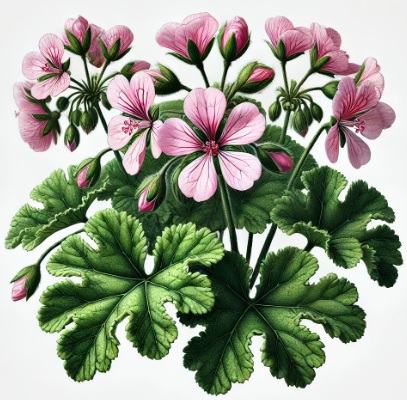Rose geranium (Pelargonium roseum), commonly known as the rose-scented geranium or , is a species of Pelargonium, which belongs to the Geraniaceae family. This plant is native to South Africa and is renowned for its fragrant, rose-scented leaves. It is commonly cultivated for its aromatic qualities and ornamental value.
Botanical Classification:
Kingdom: Plantae
Order: Geraniales
Family: Geraniaceae
Genus: Pelargonium
Species: Pelargonium roseum
Plant Characteristics:
Pelargonium roseum is characterized by:
Size and Shape: A compact, bushy perennial herb that typically grows to a height of 0.5 to 1 meter. It has a dense, rounded form.
Leaves: The leaves are rounded, deeply lobed, and covered with fine hairs that give them a velvety texture. They emit a distinctive rose-like fragrance when crushed.
Flowers: The flowers are small, often pink or pale mauve, and appear in clusters. They are less prominent compared to the leaves but add to the plant's decorative appeal.
Fruit: The fruit is a small capsule that splits open when mature to release seeds.
Soil and Light: Prefers well-drained soils and thrives in full sun to partial shade. It is well-suited to various garden conditions and can tolerate some drought.
Chemical Composition and Structure:
The chemical composition of Pelargonium roseum includes:
Essential Oils: Rich in geraniol, which contributes to its rose-like fragrance. Geraniol is also noted for its potential antimicrobial and anti-inflammatory properties.
Phenolic Compounds: These compounds contribute to the plant's aromatic profile and potential antioxidant effects.
Flavonoids: Present in the leaves, providing additional antioxidant benefits.
Uses and Benefits:
Aesthetic: Pelargonium roseum is popular in ornamental gardens due to its fragrant foliage and attractive appearance. It is often used in decorative pots and as ground cover.
Cosmetic: The essential oil derived from Pelargonium roseum is used in perfumery and skincare products for its pleasant scent and potential skin benefits, including soothing and anti-inflammatory effects.
Medicinal: Traditionally used in herbal medicine for its calming and aromatic properties. The essential oil may be used in aromatherapy for stress relief, although scientific evidence for some medicinal claims is limited.
Culinary: In some regions, the aromatic leaves are used to flavor dishes or in herbal teas.
Applications:
Gardening: Ideal for garden beds, borders, and containers. Its fragrant leaves and attractive flowers make it a popular choice for ornamental use.
Cosmetics: The essential oil is used in perfumes, lotions, and other skincare products for its fragrance and potential therapeutic properties.
Medicinal: Employed in traditional remedies and aromatherapy for its calming effects and pleasant aroma.
Culinary: Used in culinary applications for flavoring or as a garnish in some dishes and beverages.
Environmental and Safety Considerations:
Environmental Impact: Generally considered low impact when cultivated responsibly. The plant is often grown in gardens and does not pose a significant risk to local ecosystems.
Safety: Generally safe for use. Essential oils should be used with caution as they may cause skin irritation in sensitive individuals. It is advisable to perform a patch test before widespread use and consult a healthcare provider if used for medicinal purposes. People allergic to plants or with very sensitive skin should be cautious.
INCI:
Perfuming. Unlike fragrance, which can also contain slightly less pleasant or characteristic odours, the term perfume indicates only very pleasant fragrances. Used for perfumes and aromatic raw materials.
Synonyms:
CAS: 90082-55-6 EC number 290-144-2
![]() Rose geranium
Rose geranium 
